
Editor's Note: This post was originally published on Oct, 2016 and has been updated with new statistics and insights.
Content still matters deeply to B2B business. In fact:
A Regalix 2016 survey found 96% of marketers identifying content marketing as a core part of their strategy.
But what is the landscape of content marketing like today? And are the rules changing? Moreover, how can marketers keep up with content production, to appeal to the needs of their audiences? And specifically: What kinds of content are supreme today, and which metrics are becoming important?
In this article, we will answer all those questions. Content marketing statistics give an insight into the content strategies of other B2B companies. So you should often compare strategies to know how you measure up to industry standards.
Furthermore, each statistic here includes a takeaway that marketers should use to improve their B2B marketing strategy in 2017 and beyond.
Just consider this statistic:
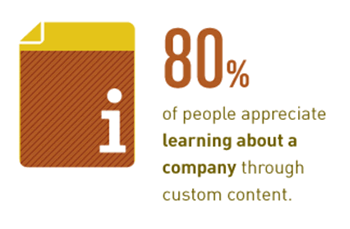
Content is still an effective tool to engage buyers for B2B business. Buyers are still happy reading, watching, and consuming content from brands they follow and trust.
But unlike content several years ago, the goals of content are changing:
The top three B2B goals of content marketing include: Lead Generation (85%); Sales (84%); Lead Nurturing (78%). (Content Marketing Institute)
Therefore, B2B marketers are using content for more than just engagement and thought leadership. Content is staking its claim as a lead generation, conversion, even sales tool. and marketers will use content to grow their business outcomes this year.
But to do this successfully, they must be fluent in matching content to a buyer’s journey.
Only then can marketers understand how buyers move down the sales funnel — and utilize content to nurture and guide them along the way.
Marketers' first priority is growing SEO/organic presence, according to Hubspot’s State of Inbound 2016 report. Yet blog content creation is a close second priority, with content distribution and amplification rounding out the top three.
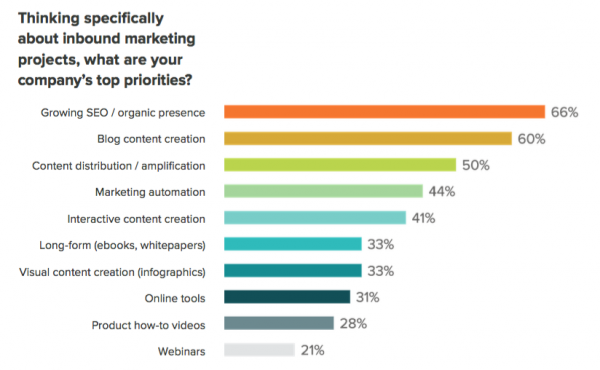 Image source: Hubspot
Image source: Hubspot
On the subject of blogs, they're still the bread and butter for many B2B marketing strategies:
“60% of marketers focus on blogs in their work.” — State of Inbound 2016
Also, blogs were the most commonly produced content marketing type worldwide in a September 2016 report from Conductor:
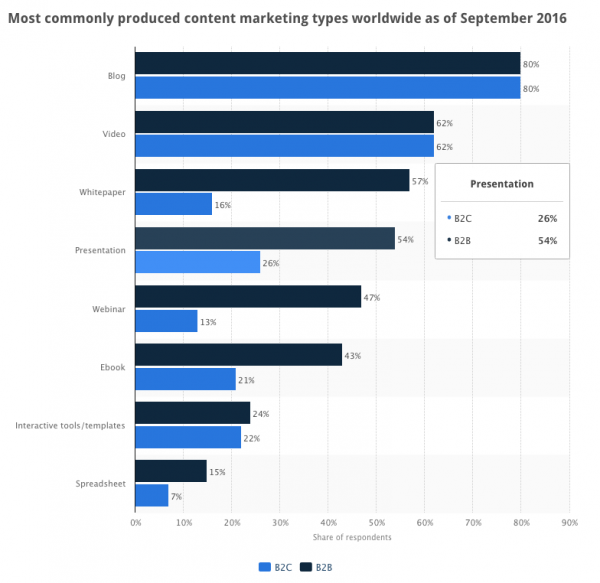 Data source: Conductor
Data source: Conductor
And although some formats are still tried and true, the sheer amount of content continues to increase YOY:
70% of B2B marketers plan to create more content in 2017 compared to 2016 (Content Marketing Institute).
But with all that content to keep up with, who is responsible for creating it? We'll explore that next.
Content creation remains an in-house responsibility at a majority of marketers. In fact, the number of Hubspot respondents identifying staff as their content writers jumped from 41% in 2015 to 71% in 2016.
Participation levels across the board — including executives, freelancers, guest posters and agency posters — were higher this year. And Hubspot took this as an indication of continued investment in creating blog content:
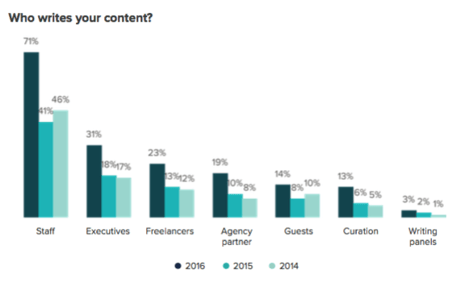 Image source: Hubspot
Image source: Hubspot
Next, the question becomes, are marketing teams effective at managing their content needs? Not quite:
Only 30% of B2B marketers in the Content Marketing Institute (CMI) and MarketingProf’s 2016 report said their organizations were effective at content marketing, compared to 28% in 2015.
Despite the increased value of content, marketing teams do not feel more effective with their plans.
But thankfully, simple strategies seem to have a large effect on the top-performing B2B companies:
According to the CMI report, effectiveness was greater among respondents who:
Clarity is hard to come by for many B2B marketers:
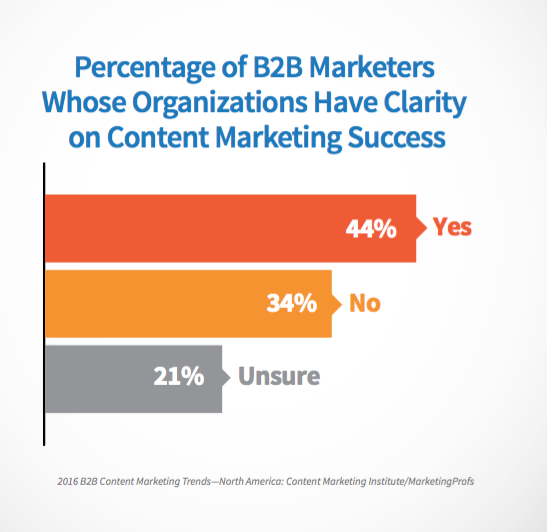 Image source: CMI
Image source: CMI
But a marketing and sales alignment can help achieve organization clarity for your content plan.
Now, how are marketers promoting their content?
Many marketers are experimenting with new content channels, Hubspot found.
For B2B marketers, 48% planned on incorporating YouTube, 39% were looking to add Facebook video, and 33% identified Instagram as the channel they’d add to the marketing mix in the next 12 months.
These top three channels were identified as the top choices to leverage in marketing efforts internationally, although messaging apps came a close fourth in Latin America and Southeast Asia.
According to a report by Experian and MarketingCharts, Facebook and Youtube are clearly the dominant channels:
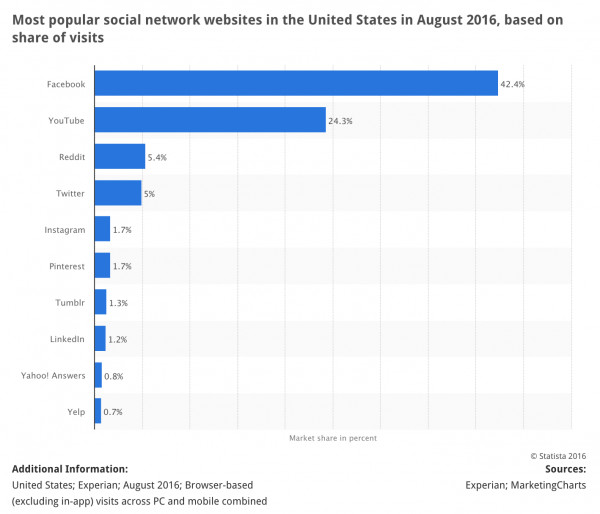
Although, with an updated layout for content, LinkedIn is increasingly important as well:
94% of B2B marketers use LinkedIn as part of their content strategy (Content Marketing Institute).
With its entirely new layout comes new best LinkedIn practices for marketers. B2B marketers should switch their company pages over to the new format immediately to begin testing strategies.

And then comes the question of mobile vs. web content:
Regalix study indicates that marketers overlook mobile content. In fact, only 11% of respondents reported an exclusive mobile content strategy — a drop from 21% who focused on mobile in 2015.
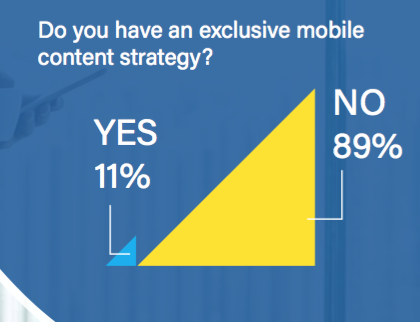 Image source: Regalix
Image source: Regalix
When seeking out new opportunities, content marketers might want to revisit their existing content marketing strategies before getting too excited about new channels.
In a survey of more than 400 B2B content marketers, Conductor found only 2 out of 5 marketers target their content. According to Ann Handley, a MarketingProfs content wiz, “Useful x Inspiration x Empathy = Effective Content.”
But segmented audiences aren't yet widespread for B2B — despite the effectiveness of targeted content.
Further, only 26% of B2B marketers gather competitive insight. Yet analyzing the competition’s content marketing strategy can help enhance your own efforts: At least 36% of the marketers recognize this, and check on the competition monthly or more often.
“If you’re not doing any type of competitive analysis, it’s likely that your content marketing strategy isn’t as great as it could be.” — Larry Kim, WordStream
As for another opportunity: In April 2016, Harris polled more than 2,000 Americans on their familiarity with content marketing. Some 46% of overall respondents had never heard of content marketing:
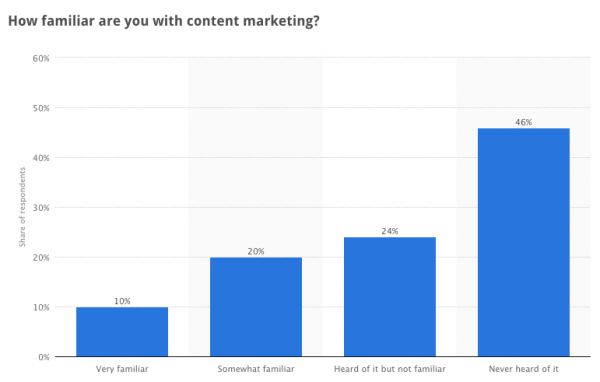 Image source: HarrisPoll
Image source: HarrisPoll
Nevertheless, the generational differences loomed large here with 65% of millennials stating they were familiar with content marketing compared to 53% of Gen Xers, 49% of Baby Boomers and 37% of Mature respondents.
So the question for savvy marketers become: How can you use content marketing to entice whole new segments of buyers, of which content isn't currently common?
Just because your industry doesn't currently have content abundance, doesn't mean it won't be an effective lead generation tool.
Next, how are marketers measuring their content — and which metrics matter?
The majority of B2B marketers plan to create more content in 2017, but that doesn’t mean it is good content. To stand out, B2B marketers must constantly analyze their content in order to produce better and better pieces.
78% of B2B marketers use ‘website traffic’ to determine how well its content marketing is producing results (Content Marketing Institute).
Website traffic is a useless metric because it does not tell your company anything. Just because a blog post received a lot of clicks, that doesn’t mean it converted actual customers. Marketers should focus on other metrics such as conversions through the funnel and qualified leads to see how well content performs.
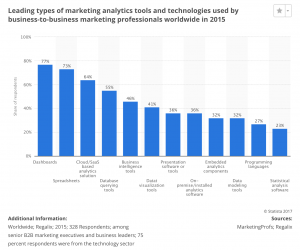
In the end, good content will grab top spots on search engines. But the most important thing for B2B business is conversions from content. And marketers must use content analytics to figure out what contributes to conversions, such as:
Then, B2B marketers must replicate strategies that work.
Still, judging content marketing ROI remains a challenge. Regalix found website traffic (64%) and conversion rates (63%) were the primary metrics marketers used in evaluating their content marketing success. CMI’s respondents, though, pointed to sales lead quality (87%), sales (84%) and higher conversion rates (82%) as their top metrics to measure success.
Marketers should continuously expand their knowledge-base in order to stay valued team members. Marketing technologies that help measure, track, and manage campaigns are on the rise:
70% of survey respondents said they expect their marketing technology budget to increase slightly (50%) or greatly (20%) in 2017 (Walker Sands).
So marketers should consider free training programs from Hubspot to improve their skill sets.
As the internet becomes a more crowded space for marketing, content marketing remains a primary strategy to boost a brand, grow traffic and reach more potential customers.
Marketers are called upon more and more to calculate an ROI on their efforts, which means B2B marketing must shift to a more analytical approach.
B2B marketers that rely on metrics such as website traffic, bounce backs, or even clicks per post will find it hard to lead a successful campaign.
Though B2B marketing can be more traditional than B2C strategies, it’s important to embrace marketing technologies that can help produce better results. There are even free (or trial-based) tools that B2B marketers can use to run more analytical campaigns.
Marketers who can provide hard data on their efforts will thrive in the new B2B marketing landscape, so becoming familiar and comfortable with analytics and data in 2017 and beyond is key.
Sources
Content Marketing Institute and MarketingProfs. (2015). B2B Content Marketing: 2016 Benchmarks, Budgets and Trends — North America. https://contentmarketinginstitute.com/2015/09/b2b-content-marketing-research/
Conductor. (2016, September). B2B Content Marketing: What Content Marketers are Doing Now (And what they should do tomorrow). https://ww2.conductor.com/rs/149-ZMU-763/images/Conductor-Research-B2B-Content-Marketing-2016.pdf
Harris Poll. (2016, April). Complete Earned Media Results. https://media.theharrispoll.com/documents/Complete+Earned+Media+Results.pdf
Hubspot. (2016, September). The State of Inbound 2016. stateofinbound.com
Regalix. (2016, May). State of B2B Content Marketing 2016. www.regalix.com
CMI. (2016, September). "2017 Benchmarks, Budgets, and Trends—North America." https://contentmarketinginstitute.com/wp-content/uploads/2016/09/2017_B2B_Research_FINAL.pdf
Walker Sands Communication. (Date N/A). "State of Marketing Technology 2017." https://www.walkersands.com/images/files/file/Whitepaper-PDFs/Walker%20Sands%20State%20of%20Marketing%20Technology_2017.pdf
by Jonathan Franchell, CEO of Ironpaper - For more tips and hacks: Need to remove a new line after h1 tags? Both web designers and SEO practitioners need to employ headline tags: H1, H2, H3 in several ways to improve web page structure and tag...

The Crowded Arena of the IT Marketplace Updated December 2024 The Information Technology (IT) landscape is experiencing rapid growth and intensifying competition. IT spending is projected to reach nearly 5.1 trillion U.S. dollars in 2024, a...

Updated December, 2024 The field of digital marketing is evolving rapidly in response to new technology and changing buyer expectations. To help career-minded marketers, we’ve rounded up the top 10 skills needed to succeed in the field. These are...
